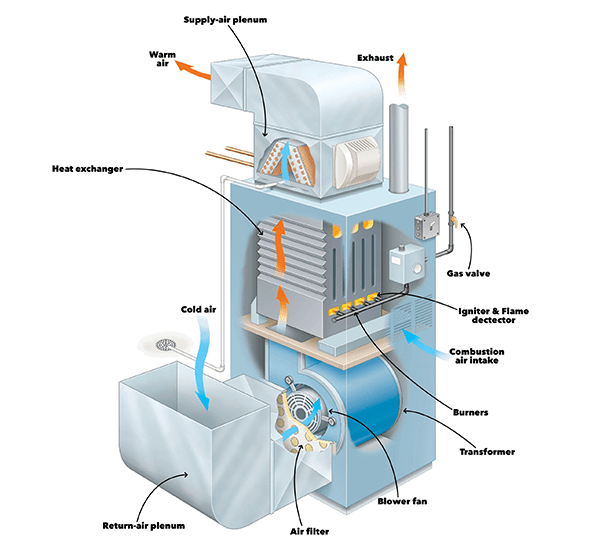Video: A Comprehensive Guide to Parts of a Furnace

Figure 1: Parts of a furnace system from laheatingairconditioning.com.
When winter arrives and the chill sets in, a reliable furnace becomes a crucial component of any home's heating system. The intricate equipment responsible for keeping us warm consists of various parts, each playing a vital role in the overall functioning of the furnace. In this guide, we will delve into the different parts of a furnace and unravel the mystery behind their functions.
1. Furnace Components and Their Functions
1.1 Thermostat: The Commander-in-Chief
At the helm of furnace operations is the thermostat, often considered the commander-in-chief of the heating system. This small device allows homeowners to set and control the desired temperature in their living spaces. When the ambient temperature falls below the set level, the thermostat sends signals to the furnace to kick into action, initiating the heating process.
1.2 Burner: Where the Magic Happens
Situated within the furnace, the burner is where the magic of transforming fuel into heat occurs. Whether fueled by natural gas, oil, or propane, the burner's primary function is to combust the fuel, generating heat in the process. A well-maintained and efficient burner is essential for optimal heating performance.

Figure 2: Blue fire in a gas furnace.
1.3 Heat Exchanger: Transferring Heat Safely
Once the burner has done its job, the produced heat moves to the heat exchanger. This component is crucial for ensuring that the heat generated from combustion is safely transferred to the air circulating throughout the system. The heat exchanger prevents the mixing of combustion gases with the breathable air, ensuring the safety of the indoor environment.
1.4 Blower Motor and Blower Fan: Circulating Comfort
The blower motor and blower fan are responsible for moving the warm air produced by the furnace throughout the ductwork and into the living spaces of a home. They enhance the circulation of heated air, ensuring a consistent and comfortable temperature throughout the house. Regular maintenance of the blower motor is essential to prevent issues such as reduced airflow and uneven heating.
1.5 Air Filter: Purifying the Flow
As the blower motor circulates air, it passes through the air filter, an often overlooked yet crucial component. The air filter serves to remove dust, debris, and other contaminants from the air, preventing them from entering the furnace and compromising its efficiency. Regularly changing or cleaning the air filter is a simple yet effective way to maintain the furnace's performance and indoor air quality.
1.6 Ignition System: Sparking the Flame
In furnaces, especially those fueled by natural gas, the ignition system is responsible for initiating the combustion process. Modern furnaces typically use electronic ignition systems, which can be either intermittent pilot or hot surface ignition. These systems ensure a controlled and efficient ignition of the burner, contributing to the overall reliability of the furnace.

Figure 3: Electronic furnace ignitor.
1.7 Flame Sensor: Ensuring Safety
Safety is paramount in any heating system, and the flame sensor plays a critical role in this regard. Located near the burner, the flame sensor detects the presence of a flame. If it doesn't sense a flame when the burner is active, it signals the control board to shut down the furnace, preventing the release of unburned gas into the living spaces.
1.8 Gas Valve: Regulating the Flow
For gas-powered furnaces, the gas valve acts as a regulator, controlling the flow of natural gas or propane to the burner. This component opens and closes in response to signals from the thermostat and other control devices. The precise regulation of gas flow ensures that the furnace produces the right amount of heat to meet the desired temperature settings.
1.9 Limit Switch: Preventing Overheating
To safeguard against overheating, furnaces are equipped with a limit switch. This switch monitors the temperature of the air in the plenum – the chamber where heated air accumulates before being distributed. If the temperature becomes too high, the limit switch shuts down the burner, preventing potential damage to the furnace and ensuring the safety of the heating system.
1.10 Ductwork: Channels of Comfort
While not a component within the furnace itself, the ductwork plays a crucial role in the overall heating system. Ducts are pathways that deliver heated air from the furnace to different rooms in a house. Properly designed and insulated ductwork ensures the efficient distribution of warm air, contributing to an even and comfortable temperature throughout the home.

Figure 4: Remodel heating ductwork.
1.11 Control Board: The Brain of the Operation
Acting as the brain of the furnace, the control board manages and coordinates the functions of various components. It receives signals from the thermostat, ignition system, and other sensors, orchestrating the heating process. If any component malfunctions, the control board can also trigger safety measures, such as shutting down the furnace to prevent potential hazards.
1.12 Exhaust Venting System: Expelling Combustion Byproducts
In gas furnaces, the exhaust venting system is responsible for safely expelling combustion byproducts, such as carbon monoxide, outside the home. It ensures that any potentially harmful gases are vented away from the living spaces, maintaining indoor air quality and safeguarding the well-being of occupants.

Figure 5: A furnace (right) and a gas boiler (left).
2. Conclusion: The Symphony of Comfort
In conclusion, a furnace is a complex yet finely tuned system of interconnected parts, each playing a crucial role
in the symphony of comfort it produces. Regular maintenance and prompt attention to any issues are essential for
ensuring the longevity and efficiency of a furnace.
Understanding the functions of these components empowers homeowners to appreciate the inner workings of their
heating systems and make informed decisions about maintenance and repairs. As we embrace the warmth provided by our
furnaces during the colder months, let us also acknowledge the intricate dance of parts working together to keep us
cozy and comfortable.



